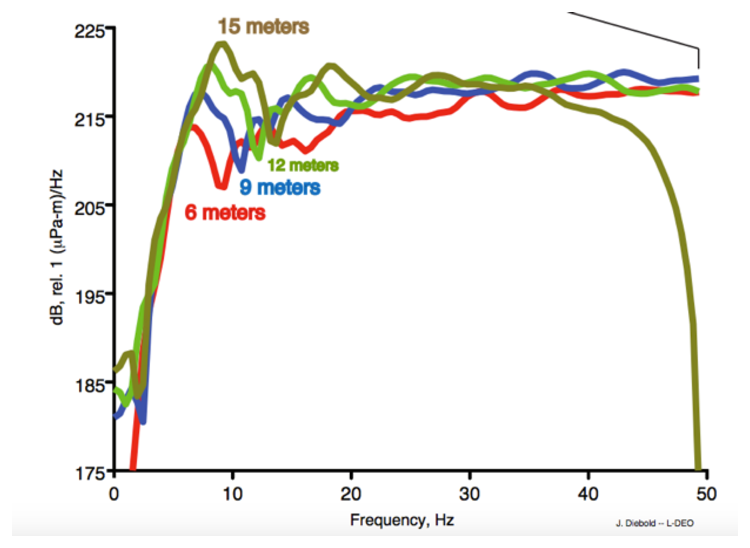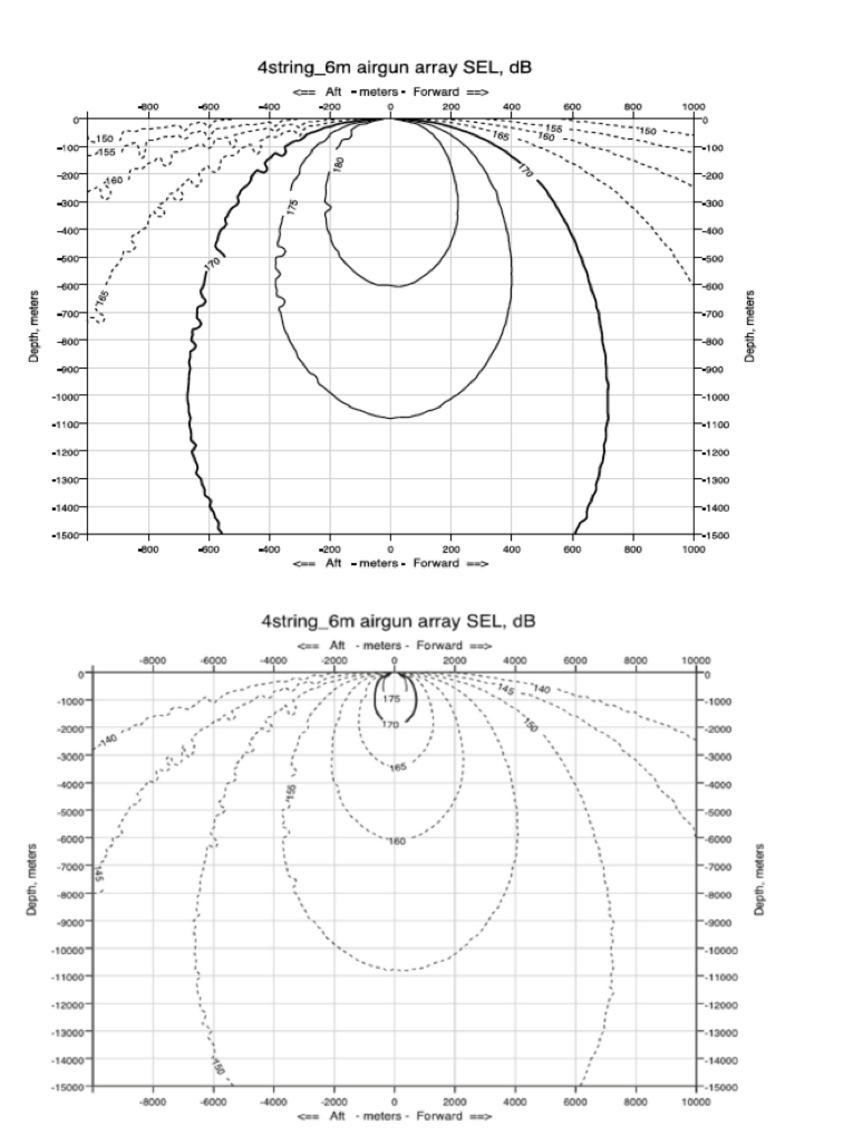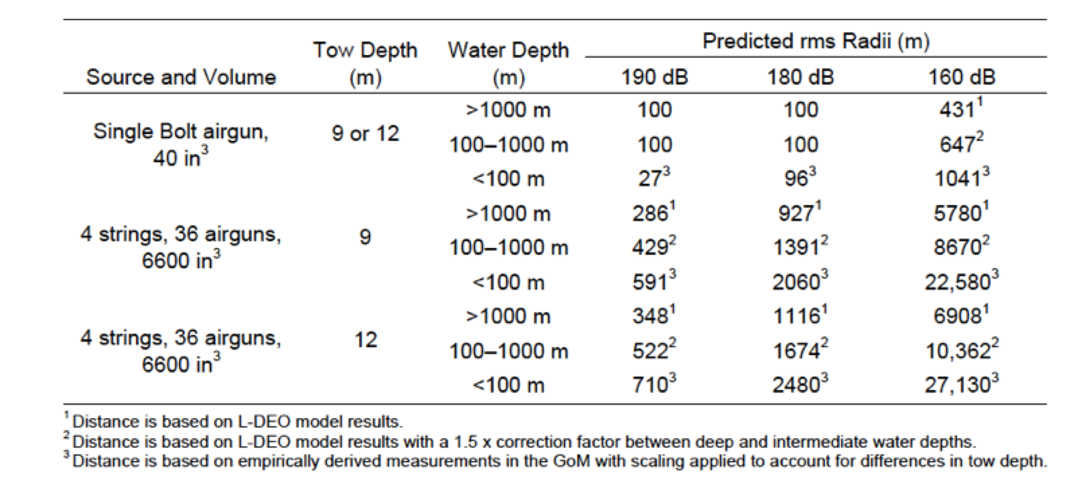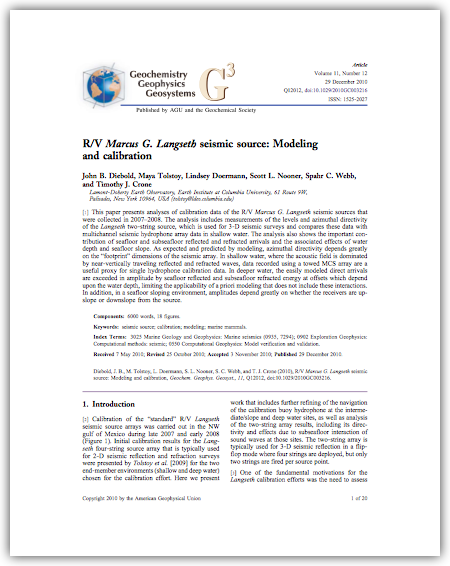A4: R/V Marcus G. Langseth Sound Source |
| MGL1521 Airgun Operations The R/V Langseth airgun array consists of 36 air guns with a total volume of 6600 in3 at 2000 psi. To enhance power and low frequencies the airguns were run at depths of 12 m for the duration of the experiment. During airgun operations the towing speed of the Langseth was 3.5 or 4 kt. The R/V Langseth seismic source consists of four identical linear arrays, or strings each of which has ten air guns. Nine air guns per string were fired on all four strings simultaneously, while the tenth was kept in reserve as a spare to be turned on in case of the failure of another air gun. Shots were fired at predetermined coordinates while on the shot lines and a 60 s intervals during transects between lines. Typically, on each string gun 5 is kept as a spare, but if there were issues with one of the other guns, gun 5 on the string in question was put in service and the other gun was shut off. Seven different volumes of Bolt Models 1500LL & 1900LLXT Long Life Air Guns are used. Guns 1 & 2 are 360 in3 and are used in parallel. Gun 3 is 40 in3. Guns 4 & 5 are 180 in3 and are used in parallel. Gun 6 is 90 in3. Gun 7 is 120 in3. Gun 8 is 60 in3. Guns 9 & 10 are 220 in3 and are used in parallel.   Figure 1: Schematic R/V Langseth gun array layout. The array comprises four identical but separately towed strings, each with ten air guns. (a) Each string is made up of three two-gun clusters and four individual guns. The purpose of the clusters is to provide a larger, more slowly reverberating residual air bubble (which improves overall array tuning) while at the same time reducing the amplitude of that bubble’s reverberation, which further improves tuning. One of the 180 in3 air guns within the central cluster is normally turned off and held in reserve as a spare. (b) Detailed side view of the towing arrangement for one of the four identical source strings on the R/V Langseth, drawn to scale for a towing depth of 6 meters. The airgun array signature depends on the towing depth (Fig. 2). We used a towing depth of 12 m.    Figure 2: Airgun signature modeled for 12-m tow depth and the frequency response at 4 different tow depths by John Diebold –LDEO using gunsig. The rate at which sound levels decay around the airgun source depends on the towing depths. Acoustic received levels were quantified using sound exposure level (SEL) calculations. In the U.S.A. the current standard for mitigation is root-mean-square (RMS). The RMS amplitude, typically expressed as dB referenced to 1 mPa, is a measure of the average pressure over the duration of the pulse. It is calculated as the square root of the sum of the squared pressures within a given time window and therefore depends on the selection of this window and its duration. SEL is a measure of the energy flux density of an arrival, defined as the product of signal intensity and duration. Its decibel value (dB referenced to 1 Pa2s) will equal the RMS decibel amplitude if calculated for a 1 s duration window: SEL(dB) = RMS(dB) + 10 log10 (T), where T is the RMS integration time in seconds. For signals with durations <1 s, as expected for an air gun pulse, the SEL value will be less than the RMS. Current practice is to use 170 dB SEL as a proxy for 180 dB for the RMS sound exposure level used in permitting. Models predicting acoustic levels for the full array were tested using a 6 m towing depth for deep water (~1600 m), intermediate water depth on the slope (~600–1100 m), and shallow water (~50 m) in the Gulf of Mexico (GoM) in 2007–2008 (Tolstoy et al. 2009; Diebold et al. 2010). Simple scaling factors were calculated using the deep water model in order to calculate acoustic levels for a 12 m tow depth (FIG. 3). During power downs a single 1900LL 40-in(_^3) airgun will be used which falls into the low energy source category (Table 1).  Figure 3: Decibel sound level for the airgun source towed at 9 and 15 m. The contours are SEL (sound exposure level), which is similar to EFD (energy flux density) and RMS sound exposure level with a fixed 1-second integration window. Table 1: Predicted distances to which sound levels ≥ 190-, 180-, and 160-dB re 1 μ Parms are expected to be received during the proposed survey in the eastern Mediterranean Sea. From the IHA and EA  |
||||||
|
|||||||
|
|||||||
|
|||||||


